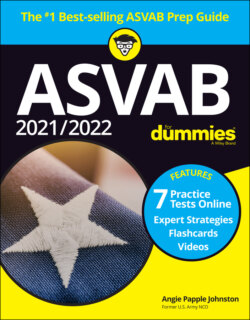Читать книгу 2021 / 2022 ASVAB For Dummies - Angie Papple Johnston - Страница 82
На сайте Литреса книга снята с продажи.
Reading between the lines: Understanding implications
ОглавлениеSome Paragraph Comprehension questions ask you to draw an inference from a stated idea. This simply means that you may need to draw a conclusion from what you’ve read. This conclusion should always be based on the reading, not your own particular opinions about a subject.
The conclusion — which may be called an inference or implication — must be reasonably based on what the passage says. You have to use good judgment when deciding which conclusions can be logically drawn from what you’ve read. Give it a shot:
Twenty-five percent of all automobile thefts occur when the doors of a car are left unlocked. People often forget to lock their doors, find it inconvenient, or tell themselves, “I’ll only be a minute.” But it only takes a minute for an accomplished car thief to steal a car. And thieves are always alert to the opportunities that distracted or rushed people present them with.
To prevent auto theft, it’s a person’s responsibility to
(A) leave the doors unlocked.
(B) never be in a rush.
(C) prevent the opportunity.
(D) be willing to perform a citizen’s arrest.
Although the paragraph doesn’t state, “It’s your own responsibility to prevent car thieves from having an opportunity to break into your car,” this idea is certainly implied. The correct answer is Choice (C). There’s no implication that people should be willing to (or can) perform a citizen’s arrest. Leaving the doors unlocked is the opposite of what one should do, and never being in a rush is probably unlikely.
An example of an unreasonable conclusion drawn from the passage would be something like “if everyone locked his or her doors, there would be no crime” or “all car thieves should be sentenced to 30 years in prison.” Nothing in this particular passage supports such a conclusion.
One way to help determine whether you’ve drawn a reasonable conclusion is to ask yourself, “Based on what I’ve just read, would the author agree with the conclusion I’ve reached?” If the answer is yes, your conclusion is probably reasonable. If the answer is no, it’s time to think up a new conclusion.
Check out another example:
Boiler technicians operate main and auxiliary boilers. They maintain and repair all parts, including pressure fittings, valves, pumps, and forced-air blowers. Technicians may have to lift or move heavy equipment. They may have to stoop and kneel and work in awkward positions.
According to this job description, a good candidate for this job would be
(A) a person with joint problems.
(B) an individual unaccustomed to heavy lifting.
(C) a person who isn’t mechanically minded.
(D) a person who’s physically fit.
Although the passage doesn’t state, “This job requires a physically fit person,” the duties listed imply that this is so. The correct answer is Choice (D). A person with joint problems may not be able to stoop or kneel or work in awkward positions. A person who’s unaccustomed to heavy lifting may not be able to lift or move the heavy equipment as needed. A person who isn’t mechanically minded may not have the knowledge necessary to maintain and repair boilers and all their parts. This leaves Choice (D) as the answer, and it’s true that a person who’s physically fit would be a good choice for the job.
